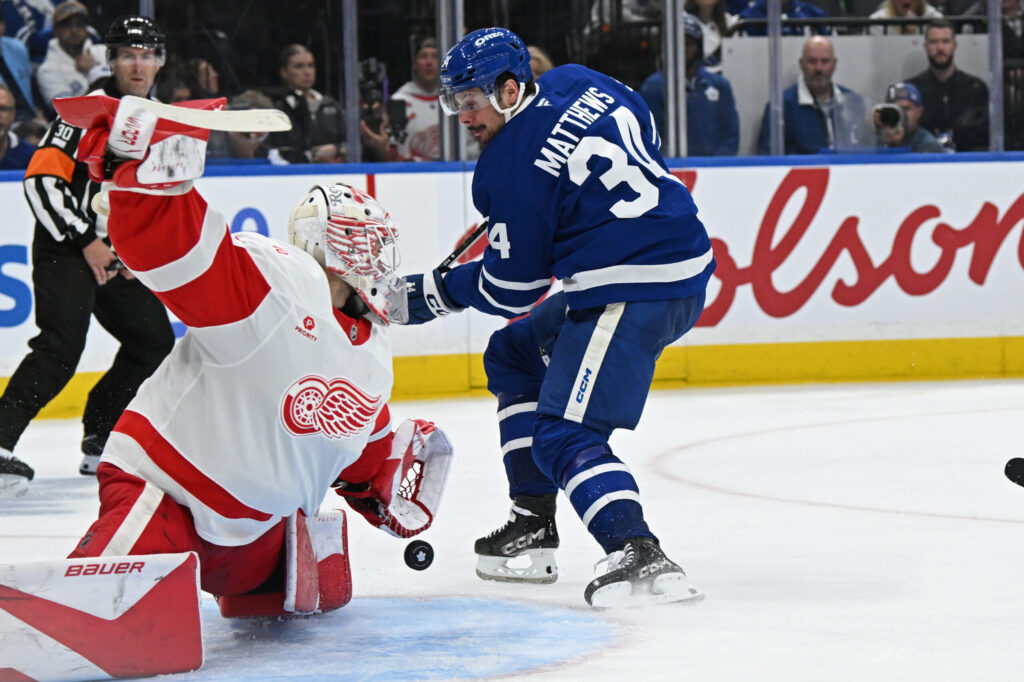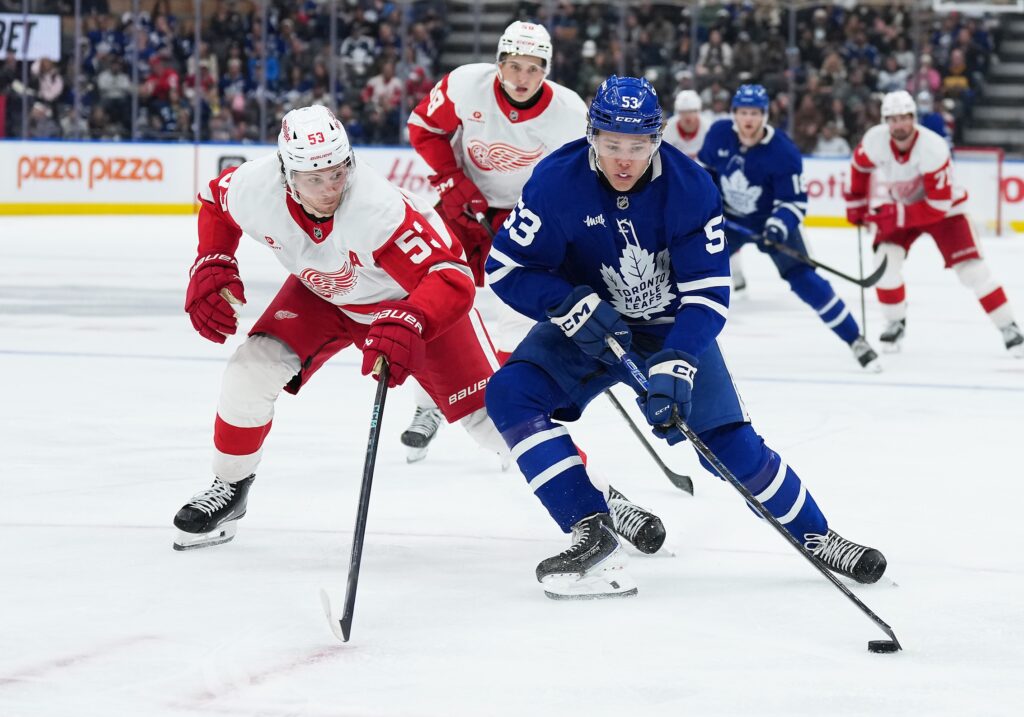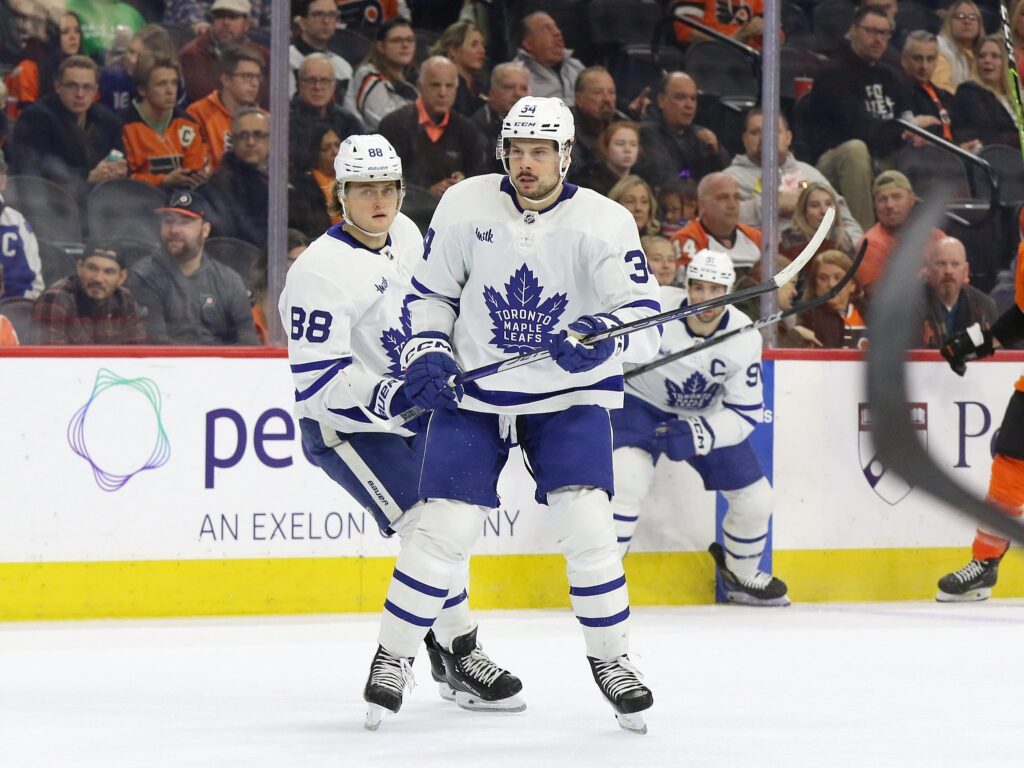For the first time in the Auston Matthews era, the Toronto Maple Leafs are confronting a new and unsettling reality: their top line is a problem. The departure of Mitch Marner didn’t just remove an All-Star; it fractured the offensive certainty that has defined this organization for years. What remains is a significant, magnified struggle to find a consistent and effective right-winger for the franchise cornerstone.
The early season has seen a revolving door on Matthews’ flank, a constant shuffling that has reportedly left coach Craig Berube “tired of the juggling.” This isn’t just minor tinkering. It’s a search for a viable combination that, so far, has yielded few answers and resulted in a meaningful deterioration in the first line’s ability to create scoring chances.
Previously on the EDGE – Why Auston Matthews’ Day Off Signals a New Era for the Maple Leafs
Unsustainable Offense: The Numbers Behind the Struggle
On the surface, the Maple Leafs are finding the back of the net. They currently sit ninth in the league in 5-on-5 rate-scoring, a figure that suggests the offence is clicking along just fine.

But a look under the hood reveals a different story. That respectable goal total is being propped up by an elevated team shooting percentage. The analytics that measure process and quality, rather than just results, are flashing red. The Leafs rank a dismal 28th in expected goals, generating a mere 2.3 expected goals per 60 minutes of 5-on-5 play.
This isn’t a statistical anomaly; it’s a symptom of a larger disease. The loss of a playmaker of Marner’s caliber, without an equitable replacement, has stung the organization. The team simply isn’t generating the quality of chances it used to.
At the epicenter of this offensive deterioration is Matthews himself. At 5-on-5, the perennial goal-scorer has looked “off.” His individual shot volume is down. The on-ice results when he’s out there have declined. Without a high-end facilitator, Matthews is being forced to spend an inordinate amount of his ice time trying to win the puck or protecting his own net. Every second he spends chasing is a second he’s not in a position to shoot, robbing him of the meaningful offensive opportunities his game is built on.
The Failed Frontrunners
Coach Berube has been experimenting heavily, giving several internal candidates a look in the coveted top-line role. The early frontrunners, however, have failed to seize the opportunity.
Max Domi was a popular pick entering the season to fill the role, but he struggled mightily to form any chemistry with Matthews. Berube has assessed Domi as “up and down” and noted he wasn’t fully healthy after missing parts of camp. The statistical results are damning. In his minutes alongside Matthews, Domi has been the least effective option, posting dire 5-on-5 numbers:
- Corsi For % (CF%): 24.14%
- Expected Goals For % (xG%): 8.39%
- Scoring Chances For % (SCF%): 6.67%
Those figures aren’t just poor; they represent a black hole.

Matias Maccelli was another top candidate who was given a shot. While he displayed creativity, quick-strike ability, and engagement in battles, he couldn’t find the consistency needed to hold the top spot. The results simply weren’t there. Maccelli may yet be a valuable piece for this team, but his skill set appears to be a better fit on the second line, where the pressure and defensive matchups are less daunting.
Promising Projects: Compete vs. Speed
With the obvious fits failing, the coaching staff has turned to other internal options, each bringing a different element to the table.
Easton Cowan, though now seemingly settled in the bottom six, showed intriguing glimpses of upside. In a 37-minute sample at 5-on-5 with Matthews and Matthew Knies, the underlying metrics were not just favourable—they were dominant. That trio posted a 74.31% xG% and a 65.63% SCF%. Cowan, cited as the best internal option so far, provided compete, playmaking vision, and an ability to hound pucks. The only issue? The goal results “didn’t really pop off.” The conversion wasn’t there, but the process was sound.

More recently, Berube has opted for a different look, assembling a line of Bobby McMann and Nicholas Robertson with Matthews. The emphasis here is clear: speed and direct play. The coach’s message to his two wingers was simple: “Use your speed” and “Don’t change who you are as a player because you are playing with Auston Matthews.” He advised them to shoot the puck when they get the chance, signaling a desire for a “working line” with skill, rather than trying to find another pure playmaker.
Previously on the EDGE – Enough’s Enough: Stolarz’s Fiery Critique Puts Maple Leafs’ Culture on Trial
The ‘Ultimate Move’: Breaking the Glass for Nylander
Through all the tinkering, Berube has held one option in his back pocket, a combination he clearly views as a last resort: moving William Nylander to Matthews’ wing.
The coach’s preference for balance across his top lines is well-known. Stacking the top unit, while potent, can leave the rest of the lineup vulnerable. But with the experiments failing, Berube recently found he had “no choice” but to try it.
The results were immediate and effective. In their first game together, the top line with Nylander looked dangerous for the first time all season. They posted strong 5-on-5 metrics, including a 54.55% CF% and a 75% SCF%. Nylander himself was a catalyst, scoring on a breakaway. He is, unequivocally, a great fit. Berube can always fall back on this option, but it remains a solution that robs Peter to pay Paul.
The Search for a Permanent Fix
While the Matthews-Nylander duo provides a high-end, in-house patch, the long-term solution likely lies outside the current roster. General Manager Brad Treliving is known to be continuing his search for top-six help via the trade market.
This, however, requires patience—waiting for the right trade partner and the right fit to emerge. It also requires assets, which could be a significant hurdle for a front office that has already dealt a number of picks and prospects.
The Leafs can continue to lean on their superstar pairing, but it’s a stopgap, not a strategy. Without a significant and permanent fix for the hole on the top line, the organization risks wasting another year of its core, running hard on the “treadmill of mediocrity” while the biggest question mark on the roster remains unsolved.
Created with the aid of Gemini AI
